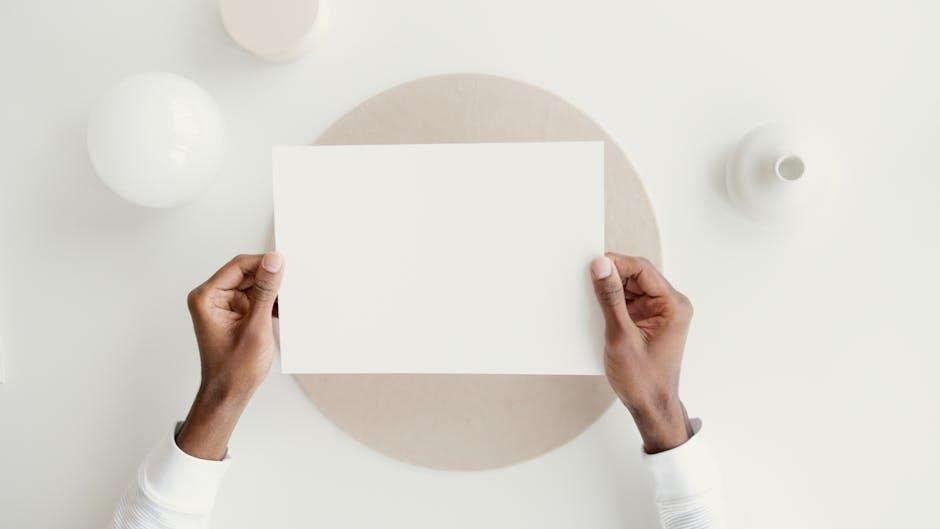To fit Roman blinds properly, follow the instructions carefully, using the provided guide and video tutorials for a successful installation process always ensuring safety first and accuracy․
Overview of the Fitting Process
The fitting process for Roman blinds involves several key steps, starting with measuring and planning, followed by the installation of the headrail and brackets, and finally, the fitting of the blind itself․ This process requires attention to detail and careful consideration of safety factors to ensure a successful installation․ The use of video tutorials and guides can help to simplify the process and provide a clear understanding of the steps involved․ By following the instructions carefully and taking the necessary precautions, individuals can achieve a professional-looking finish and enjoy the benefits of their new Roman blinds․ The overall goal of the fitting process is to achieve a safe and functional installation that meets the individual’s needs and enhances the appearance of their window․ Proper installation is crucial to ensure the blind functions correctly and safely․

Preparation for Fitting Roman Blinds
Prepare by gathering necessary tools and materials for installation, ensuring a smooth process always․
Measuring and Planning for Safe Installation
To ensure a safe and proper installation, measuring and planning are crucial steps in the process of fitting Roman blinds․
The measurements of the window and the blind itself must be taken accurately to avoid any mistakes during installation․
A thorough planning process will help identify any potential issues that may arise during the installation, such as the location of the brackets and the headrail․
It is essential to consider the type of window and the surrounding area to determine the best approach for installation․
By taking the time to measure and plan carefully, individuals can ensure a safe and successful installation of their Roman blinds․
This will also help to prevent any accidents or injuries that may occur during the installation process․
Proper measurement and planning will result in a well-installed blind that functions correctly and provides the desired level of privacy and light control․
The internet provides various resources and guides to help with measuring and planning for safe installation․

Understanding the Components of Roman Blinds
Components include headrail, brackets, and fabric, essential for proper function and installation of Roman blinds always requiring careful consideration and handling during fitting process․
Headrail and Bracket Installation
To install the headrail and brackets, start by attaching the brackets to the wall, making sure they are level and securely fastened․ The headrail can then be fitted into the brackets, ensuring it is properly seated and aligned․ It is essential to follow the manufacturer’s instructions for the specific type of blind being installed, as the process may vary slightly․ The headrail and brackets should be handled with care to avoid damage or injury․ By taking the time to properly install the headrail and brackets, the rest of the blind installation process will be much smoother and more successful․ Proper installation of these components is crucial for the overall functionality and safety of the blind, and should not be rushed or taken lightly, always ensuring a secure and level fit․

Fitting the Blind
Fitting the blind requires precise measurements and careful handling to ensure proper installation and function always using correct tools and techniques for a successful process․
Situating the Front Lip of the Headrail
To ensure a proper fit, situate the front lip of the headrail into the front of the bracket, making sure it is securely in place․ This step is crucial for the overall installation process․
The headrail should be pushed upwards to secure it, and the front lip should be aligned with the bracket for a smooth operation․
It is essential to double-check the alignment to avoid any issues with the blind’s functionality․
By following these steps, you can ensure a successful installation of your Roman blind, and it will be ready to use․
The front lip of the headrail plays a vital role in the blind’s operation, and its correct placement is essential for a proper fit․
Proper installation will provide a safe and functional blind, and it will be a valuable addition to any room․
The process requires attention to detail and careful handling to achieve the desired result․
Important Safety Considerations
Ensure minimum 150cm installation height for safety reasons always during the process of fitting the blinds to avoid accidents․
Minimum Installation Height for Safety
The minimum installation height for safety is a crucial aspect to consider when fitting Roman blinds․ According to the guidelines, the top of the blind should be installed at least 150cm from the floor․ This measurement is essential to prevent accidents, especially in homes with children or pets․ The installation height is critical in ensuring that the blinds are safely out of reach․ It is also important to note that this height requirement may vary depending on the specific type of blind and the manufacturer’s instructions․ By adhering to this safety guideline, homeowners can enjoy their Roman blinds while minimizing the risk of accidents․ The 150cm height requirement is a standard safety protocol that should be followed during the installation process to ensure a safe and secure environment․ This safety consideration is vital when installing Roman blinds․

Placement Options for Roman Blinds
Inside or outside window placement options are available for Roman blinds installation purposes always ensuring correct․
Inside vs Outside Placement for Aesthetics and Functionality
When deciding on the placement of Roman blinds, it is essential to consider both aesthetics and functionality․ Inside placement can create a sleek and elegant look, making the window appear more refined․ On the other hand, outside placement can make the window appear larger, which can be beneficial for smaller rooms․ The choice between inside and outside placement ultimately depends on personal preference and the specific design of the room․ Additionally, considering the type of window and the amount of natural light desired can also influence the decision․ By weighing these factors, individuals can make an informed decision that meets their needs and enhances the overall appearance of the room․ Proper placement can significantly impact the overall ambiance and functionality of the space, making it crucial to consider all options carefully․



